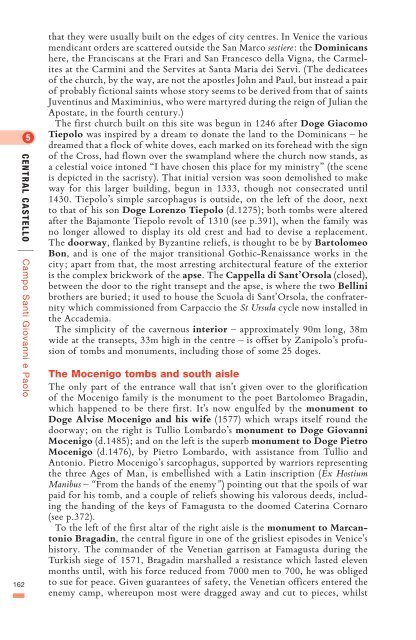You also want an ePaper? Increase the reach of your titles
YUMPU automatically turns print PDFs into web optimized ePapers that Google loves.
central castello<br />
|<br />
162<br />
Campo Santi Giovanni e Paolo<br />
that <strong>the</strong>y were usually built on <strong>the</strong> edges of city centres. In <strong>Venice</strong> <strong>the</strong> various<br />
mendicant orders are scattered outside <strong>the</strong> San Marco sestiere: <strong>the</strong> Dominicans<br />
here, <strong>the</strong> Franciscans at <strong>the</strong> Frari <strong>and</strong> San Francesco della Vigna, <strong>the</strong> Carmelites<br />
at <strong>the</strong> Carmini <strong>and</strong> <strong>the</strong> Servites at Santa Maria dei Servi. (<strong>The</strong> dedicatees<br />
of <strong>the</strong> church, by <strong>the</strong> way, are not <strong>the</strong> apostles John <strong>and</strong> Paul, but instead a pair<br />
of probably fictional saints whose s<strong>to</strong>ry seems <strong>to</strong> be derived from that of saints<br />
Juventinus <strong>and</strong> Maximinius, who were martyred during <strong>the</strong> reign of Julian <strong>the</strong><br />
Apostate, in <strong>the</strong> fourth century.)<br />
<strong>The</strong> first church built on this site was begun in 1246 after Doge Giacomo<br />
Tiepolo was inspired by a dream <strong>to</strong> donate <strong>the</strong> l<strong>and</strong> <strong>to</strong> <strong>the</strong> Dominicans – he<br />
dreamed that a flock of white doves, each marked on its forehead with <strong>the</strong> sign<br />
of <strong>the</strong> Cross, had flown over <strong>the</strong> swampl<strong>and</strong> where <strong>the</strong> church now st<strong>and</strong>s, as<br />
a celestial voice in<strong>to</strong>ned “I have chosen this place for my ministry” (<strong>the</strong> scene<br />
is depicted in <strong>the</strong> sacristy). That initial version was soon demolished <strong>to</strong> make<br />
way for this larger building, begun in 1333, though not consecrated until<br />
1430. Tiepolo’s simple sarcophagus is outside, on <strong>the</strong> left of <strong>the</strong> door, next<br />
<strong>to</strong> that of his son Doge Lorenzo Tiepolo (d.1275); both <strong>to</strong>mbs were altered<br />
after <strong>the</strong> Bajamonte Tiepolo revolt of 1310 (see p.391), when <strong>the</strong> family was<br />
no longer allowed <strong>to</strong> display its old crest <strong>and</strong> had <strong>to</strong> devise a replacement.<br />
<strong>The</strong> doorway, flanked by Byzantine reliefs, is thought <strong>to</strong> be by Bar<strong>to</strong>lomeo<br />
Bon, <strong>and</strong> is one of <strong>the</strong> major transitional Gothic-Renaissance works in <strong>the</strong><br />
city; apart from that, <strong>the</strong> most arresting architectural feature of <strong>the</strong> exterior<br />
is <strong>the</strong> complex brickwork of <strong>the</strong> apse. <strong>The</strong> Cappella di Sant’Orsola (closed),<br />
between <strong>the</strong> door <strong>to</strong> <strong>the</strong> right transept <strong>and</strong> <strong>the</strong> apse, is where <strong>the</strong> two Bellini<br />
bro<strong>the</strong>rs are buried; it used <strong>to</strong> house <strong>the</strong> Scuola di Sant’Orsola, <strong>the</strong> confraternity<br />
which commissioned from Carpaccio <strong>the</strong> St Ursula cycle now installed in<br />
<strong>the</strong> Accademia.<br />
<strong>The</strong> simplicity of <strong>the</strong> cavernous interior – approximately 90m long, 38m<br />
wide at <strong>the</strong> transepts, 33m high in <strong>the</strong> centre – is offset by Zanipolo’s profusion<br />
of <strong>to</strong>mbs <strong>and</strong> monuments, including those of some 25 doges.<br />
<strong>The</strong> Mocenigo <strong>to</strong>mbs <strong>and</strong> south aisle<br />
<strong>The</strong> only part of <strong>the</strong> entrance wall that isn’t given over <strong>to</strong> <strong>the</strong> glorification<br />
of <strong>the</strong> Mocenigo family is <strong>the</strong> monument <strong>to</strong> <strong>the</strong> poet Bar<strong>to</strong>lomeo Bragadin,<br />
which happened <strong>to</strong> be <strong>the</strong>re first. It’s now engulfed by <strong>the</strong> monument <strong>to</strong><br />
Doge Alvise Mocenigo <strong>and</strong> his wife (1577) which wraps itself round <strong>the</strong><br />
doorway; on <strong>the</strong> right is Tullio Lombardo’s monument <strong>to</strong> Doge Giovanni<br />
Mocenigo (d.1485); <strong>and</strong> on <strong>the</strong> left is <strong>the</strong> superb monument <strong>to</strong> Doge Pietro<br />
Mocenigo (d.1476), by Pietro Lombardo, with assistance from Tullio <strong>and</strong><br />
An<strong>to</strong>nio. Pietro Mocenigo’s sarcophagus, supported by warriors representing<br />
<strong>the</strong> three Ages of Man, is embellished with a Latin inscription (Ex Hostium<br />
Manibus – “From <strong>the</strong> h<strong>and</strong>s of <strong>the</strong> enemy”) pointing out that <strong>the</strong> spoils of war<br />
paid for his <strong>to</strong>mb, <strong>and</strong> a couple of reliefs showing his valorous deeds, including<br />
<strong>the</strong> h<strong>and</strong>ing of <strong>the</strong> keys of Famagusta <strong>to</strong> <strong>the</strong> doomed Caterina Cornaro<br />
(see p.372).<br />
To <strong>the</strong> left of <strong>the</strong> first altar of <strong>the</strong> right aisle is <strong>the</strong> monument <strong>to</strong> Marcan<strong>to</strong>nio<br />
Bragadin, <strong>the</strong> central figure in one of <strong>the</strong> grisliest episodes in <strong>Venice</strong>’s<br />
his<strong>to</strong>ry. <strong>The</strong> comm<strong>and</strong>er of <strong>the</strong> Venetian garrison at Famagusta during <strong>the</strong><br />
Turkish siege of 1571, Bragadin marshalled a resistance which lasted eleven<br />
months until, with his force reduced from 7000 men <strong>to</strong> 700, he was obliged<br />
<strong>to</strong> sue for peace. Given guarantees of safety, <strong>the</strong> Venetian officers entered <strong>the</strong><br />
enemy camp, whereupon most were dragged away <strong>and</strong> cut <strong>to</strong> pieces, whilst







